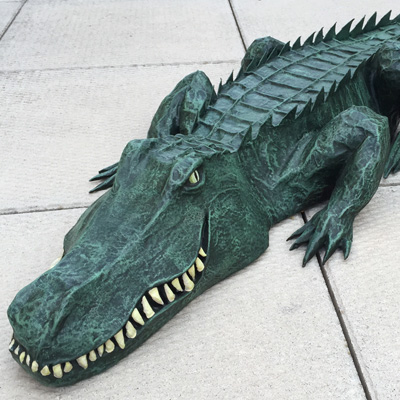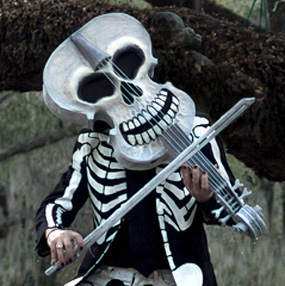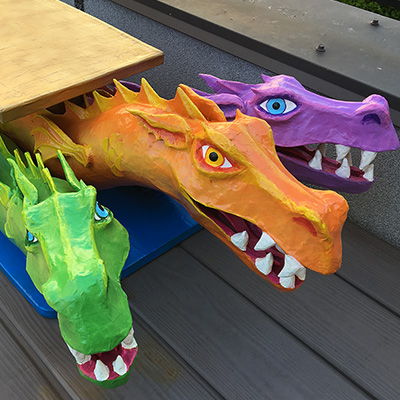Making paper maché shapes with a reusable base
Published by Manning on April 7th, 2018
This is my method for creating multiple paper maché copies of a shape using a reusable base. I’ve tried different variations on these steps over the last few years and have settled on this process as my favorite.
Start with a base
First, you wanna build a base for your sculpture, so that you can cover it in paper maché and make copies of it. A lot of my bases are made out of foam board and tons and tons of tape. Sometimes I use plastic bowls and baskets, styrofoam cups, foam insulation tubing, etc. Depending on the shape you’re going for, you could use just about anything. However, if you’re making multiple paper maché copies, I recommend against starting with anything hard and solid, like glass, metal, clay, stone, very hard plastic, etc. I’ll explain why in a bit — look, I’ll even do an asterisk: *
Release agent
Before putting paper maché on your base, you want to cover your base with a release agent. This is a layer of any kind of material that will let you easily separate the paper maché from your base. Depending on the shape and level of detail on your base, different materials might work better than others for this. I’ll give you a few examples…
Aluminum foil — If you’re working with a large, relatively smooth shape (let’s say a sphere, or simple skull shape), aluminum foil is a great release agent. You can cover your shape with foil, attach it here and there with masking tape, and then add paper maché. When it’s dry you can cut open the paper maché and the paper will stick to the foil but the foil will lift right off of your base.
Plastic shopping bags — You can also wrap your base shape with plastic bags and tape, and then add paper maché. The bags will stick inside the paper maché but they won’t stick to the base. If you use this method, it’s important that you put enough tape around the plastic bags so that they can’t slip and slide around at all; you want the bags on there as tight and secure as you get ’em before starting paper maché.
Plastic wrap — Plastic wrap (like Saran wrap) is harder to work with, but it can do a better job of wrapping onto more complex shapes and not covering up too much of your details. I find that paper maché on plastic wrap also takes a lot longer to dry than these other materials.
Note: it’s important for all these release agents that you don’t tape the materials to the base; only tape them to themselves. For example, if your plastic bags are taped down on your mask, it will make them much, much harder to remove along with the paper maché.
Petroleum jelly — I’ve never used this method because it sounds messy! But it’s a popular method so I wanted to list it. If you cover your base (let’s say a clay sculpture) with petroleum jelly, and then apply paper maché over that, you should be able to get the paper maché off pretty easily, but this comes with a few problems. The petroleum jelly might seep into the inner layer(s) of your paper maché a little bit, so this method is only safe if you plan to do a lot of layers — I’m gonna say at least six or eight. If you’re making a mask, you’ll have that gross coating of petroleum jelly inside that you’ll have to do something about; I’m sure you could wipe some of it away, and then maybe do an inner layer of paper maché to cover the rest? But if you’re just doing a sculpture you might not have to worry about it, as any remaining grossness would be hidden inside. Anyway, this all sounds like too much mess and hassle for me.
Shipping tape and masking tape — I love using tape as a release agent, but only if I’m going to be destroying the base as I remove it; not for a reusable base. Tape is great because you can cover your base very carefully and very accurately with it, but it still sticks to the paper maché a bit too much to remove easily. If you’re opening up the sculpture and destroying the base, you can carefully peel all the tape off from the inside. But if you’re doing a reusable base, with tape you’ll never be able to open up the paper maché and remove it all in one or two big pieces from the base.
So when I’m doing a one-time sculpture, tape is actually my preferred release agent, but for a reusable base it’s usually either aluminum foil or plastic shopping bags.
Paper maché
Once you’ve got your release agent layer all ready, then it’s time for paper maché. You can read about my paper maché process and materials here. The short version is: I use Roman PRO-543 universal wallpaper adhesive (paid link) and alternating layers of newspaper and brown wrapping paper.
Depending on the piece, how big it is, how durable it needs to be, etc, I usually do anywhere from four to ten layers of paper maché. You want to let this dry 100% before moving on to the next step where you open up the paper maché and remove it from the base. Even if the outer surface is dry, the inner layers might still be damp. If you try to cut paper maché while it’s even a little bit damp, you’ll get edges that are shredded up and mushy, and they won’t want to line back up nice and smoothly.
Sunlight and/or an electric fan can really speed up drying time!
Removing the paper from the base
To remove the paper maché from the reusable base, I draw a wavy line with a marker all the way around the paper maché, and then I use a brand new X-acto blade to carefully cut along the line.
Cutting a wavy line is better than a straight line, because it’ll be easier to line the pieces back up, like puzzle pieces, when you’re closing up the sculpture.
A new X-acto blade is important, because it’ll be easier to cut a clean, deep line — and also because a less-sharp blade will be more likely to slip and jump! A dull blade makes it much harder to cut and the edges will be much rougher.
ALWAYS CUT AWAY FROM YOURSELF! This is crucial. Figure out an angle where you can pull the blade out to the side, away from yourself, and nowhere near your other hand that’s securing the piece. Often I find that holding the piece against a countertop or table or chair a certain way will allow me to cut away from myself more easily. It depends on the shape!
When cutting through the paper maché, remember you need to make sure you’re cutting through all those layers of paper, plus all the way through the release agent, and hopefully a little bit into the base materials as well. You’ll need to cut through all of that, all the way around, in order to easily remove the paper maché. If you don’t go deep enough in a few spots, you’ll cut your line all the way around, and then you’ll find you can’t pull the paper maché halves apart no matter how hard you try, and you won’t know where the problem is, so you’ll end up having to cut your way around the line over and over again until you separate everything completely. It’s easier if you take the time to do this carefully in the first go-round, and your line will be much cleaner too — which means it’ll be easier to close the shape up and make it nice and smooth.
*Hard versus soft base materials
Remember that asterisk? Here it is! One very important point I’ve learned: if your base is made from hard/solid materials, it’ll be much, much harder to cut and remove. I’ll use the example of a wine bottle with a plastic bag and tape wrapped around it, and paper maché over that. When I’ve gone to cut through the paper maché, the blade goes through most or all of the paper, but weirdly when it tries to cut through the plastic bag against the glass, somehow the hardness of the glass behind the plastic protects the plastic from getting cut. You end up with your paper maché halves cut and separated, but they’re stuck to the plastic, and you can’t get the plastic to split, so you can’t get the paper off. It turns into a thing where you’re sawing away at the plastic bag for ages, separating it bit by bit. It’s no fun.
Also, with a hard surface in your base, you greatly increase the risk of the blade slipping! You’re much more likely to accidentally cut yourself when trying to cut against a hard base. On the rare occasions I have to do it, it’s really nerve-wracking, and it takes forever, and the results are always a little bit messy since it’s hard to cut a clean line in one go.
Now, if your base were a wine bottle with bubble wrap and tape wrapped around it, and then a plastic bag as a release agent, that would be fine, because the blade could go through the paper maché and the plastic bag and slightly into the bubble wrap. You could cut through all of that and easily remove the halves.
Where was I?
Oh yeah! Anyway, once you’re successfully cut through the paper maché, if you’ve done everything right you should be able to pull apart the halves pretty easily. If you’ve used aluminum foil as your release agent, you might find that most of it is permanently stuck inside the paper maché; no big deal. If you’re used plastic bags or plastic wrap, you can probably pull it all out of there pretty easily.
Closing up your sculpture
To reconnect and close up the paper maché halves, I tape them together with masking tape, completely covering the seam. In order to conceal the seam as much as possible, I usually use two layers of tape here. I then cover all the tape with paper maché — anywhere from 2-6 layers, depending on how strong I need that connection to be.
If you haven’t done a great job cutting, and you only use one layer of tape and one or two layers of paper maché, you might find that the seam is a little bit visible in the finished piece. If you were able to cut your line really clean, and you cover it with several layers of stuff, you can probably make it disappear completely.
Let that stuff dry, and your first paper maché copy is done! One to the next one…
Repairing the base
Before starting the next copy, I’ll take a look at the base and see how cut-up it is from the X-acto blade. At this point I often cover those cuts with some masking tape, just to keep the shape as sturdy as possible. If you’re only doing two or three copies, you might not need to do this. If you’re doing a lot of copies, it helps to continually repair the base before each copy, to keep the thing from falling apart. This all depends on what materials you’ve used.
That’s about it!
Here are a few projects you can check out where I’ve used these methods: twin skull masks, baby chicks, three-headed sea serpent, giant gummi bears, giant candy canes, and I’m currently working an experiment where I’m making a dozen or so severed heads with different materials for comparison — I’ll have an article on that coming out around Halloween 2019.
Good luck, have fun!


 About Manning Krull
About Manning Krull How to make a 4-foot paper maché alligator
How to make a 4-foot paper maché alligator My violin skull mask, Mardi Gras 2015
My violin skull mask, Mardi Gras 2015 Three-headed paper maché dragon sculpture
Three-headed paper maché dragon sculpture
Leave a comment